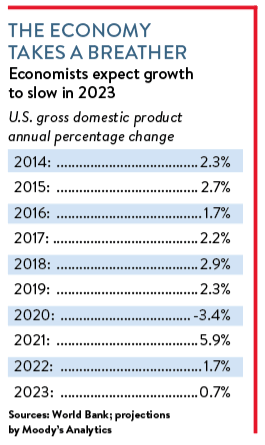Here are three ways your job may be wrecking the quality of your rest. Some…
While gathering clouds and growing turbulence seem tempestuous in 2023, will the skies be cloudy all year?

A slowing economy will put downward pressure on retail sales in 2023. Although healthy employment will provide consumers with spending money, less robust activity in housing, distribution and manufacturing will hamper growth. Retailers can prepare for a tougher environment by tracking cash flow closely, investing selectively and hiring prudently.
After two years of frenetic activity, retailers will confront a tough operating environment in 2023. Growing headwinds include rising inflation, higher interest rates, a softening housing market, continuing supply chain disruptions, declining capital investments and escalating costs for wages and energy.
“2023 is likely to be a challenging year for retailers,” says Scott Hoyt, senior director of consumer economics for Moody’s Analytics, an economic research and financial consulting company based in New York. “We are projecting growth of only 2.8%, well below the sector’s historic 4.3% average.” The forecast represents a decline from the 8.3% increase expected when 2022 numbers finally are tallied. The recent trend is well below 2021 with its 17.5% increase fueled by a consumer shift away from services and toward goods.
“Of the many factors weighing on growth, the biggest will be a slowdown in inflation, since retail activity is measured in nominal terms,” Hoyt says. Moody’s Analytics forecasts that by the end of 2023, inflation will have declined from its recent 8% pace to the 2% target favored by the Federal Reserve.
Inflation is kind of a two-edged sword because it helps raise merchandise prices but dampens shopper behavior. While retailers will be hurt by a decline in inflation over the coming 12 months, rising prices have not been a panacea in 2022. “Inflation is particularly pernicious for retailers right now because it is running higher today for goods than for services,” Hoyt says. “That has been encouraging consumers to switch to more spending on the latter.”
As for the current state of shopper psychology, it remains as unsettled as it was a year ago. “It’s hard to get a handle on consumer confidence right now,” Hoyt says. “If you ask people about their finances and they think about the stock market or gasoline prices compared with a year ago, they’re really depressed. If you ask them about the labor market and their job situation, they’re feeling pretty good.”

Other factors that will weigh on retail activity in 2023 include the loss of some helpful economic initiatives. “Government stimulus packages, ultra-low interest rates and strong money supply creation had been helping to compel business activity until mid-2022,” says Anirban Basu, chair and chief executive officer of Baltimore-based Sage Policy Group. “All those fundamentals have been inverted.”
The deceleration in retail operations is echoed in the larger economy. “We expect real gross domestic product to increase by 0.7% in 2023,” says Bernard Yaros Jr., assistant director and economist for Moody’s Analytics. “The projection for 2022 is 1.7%. Both figures represent much slower activity than the 5.9% increase of 2021.” (GDP, the total of the nation’s goods and services, is the most commonly accepted measure of economic growth. Real GDP adjusts for inflation.)
Moody’s Analytics projects the slowdown in the overall economy will have a depressing effect on corporate profits to increase at a 5.2% clip in 2023. That represents a decline from the 7.9% figure anticipated for 2022. Both estimates are lower than the 25% increase of 2021.
Healthy employment
Reports from the field support the analysis of economists. “In the first half of 2022 many of our members were still experiencing high demand,” says Tom Palisin, executive director of The Manufacturers’ Association, a York, Pennsylvania-based regional organization with more than 390 member companies. “But as the year progressed, there was a significant slowdown caused by the labor shortage, inflationary issues and global events.”
With its diverse membership in food processing, defense, fabrication and machinery building, Palisin’s association is something of a proxy for all American industry. The good news is that strong employment conditions at the association’s members — as well as at companies elsewhere in the nation — is helping alleviate the negative impact of the economy’s headwinds. Moody’s Analytics expects a continuation of that favorable condition, forecasting an unemployment rate of 4.1% by the end of 2023. That’s not much higher than the 3.7% rate of late 2022. (Many economists peg an unemployment rate of between 3.5% and 4.5% as the “sweet spot” that balances the risks of wage escalation and economic recession.)
High employment levels tend to spark wage increases that fill workers’ pockets with cash to spend at retailers. “Wage rates, as measured by the Employment Cost Index, remain very high by the standards of the last couple of decades,” Hoyt says. Increases in 2023 are expected to come in at 3.7%, a healthy level that reflects the strong growth of a tight labor market. “While we’ve had growth over 3% for the last three years, prior to 2020, the last time we had growth in the ECI of over 3% was 2007,” he says. On the flipside, higher wages increase operating costs that can dampen profits.
Worker shortage
The tight labor market hits business profitability not only in higher wages, but also in a scarcity of workers needed for retail operations. “Employers will be very focused on labor availability in 2023 as baby boomers continue to retire and the supply of immigrant labor has yet to fully recover from severe Covid-19 pandemic-related disruptions,” Yaros says. “Despite a slowing economy, layoffs are low, indicating that businesses are holding onto labor in a reaction to the hiring difficulties they encountered during the pandemic.”
When will the available workforce grow? Not anytime soon, observers say. “The labor market’s going to be tight for years to come,” says Bill Conerly, principal of a consulting firm in Lake Oswego, Oregon. “The decade from 2020 to 2030 is expected to have the lowest growth of working age population since the Civil War. One reason is the retirement of the baby boomers.”
Palisin agreed that a labor shortage is going to be a long-term condition and said his members are making moves to lessen the effect. “Employers are trying to be creative in the way they keep and retain workers, not only by offering higher salary rates but also by extending benefits and encouraging work flexibility. They are also investing more in automation for labor-intensive tasks.”
Supply disruptions
Higher wages and scarce workers are not the only forces threatening retail profits. Another major factor is a rise in interest rates — the Federal Reserve’s favorite tool for fighting inflation. “The purpose of increasing interest rates is to drive down demand,” Palisin says. “So, our members are expecting to see a decrease in new orders that will impact the overall economy. Also, many of our companies have lines of credit that rely on floating interest rates. Rising rates will take a hit to the bottom line as companies decide whether to use those lines of credit to support their cash flow and investments.”
Adding further downward pressure are the disruptions in the delivery of goods that continue to plague retailers large and small. “Supply chain problems have improved over the past year, but there hasn’t been the significant resolution we had hoped for,” Palisin says. “Random shortages in materials and deliveries are still plaguing our members, and that’s leading to backlogging of orders. Companies just can’t get materials or parts.”
To complicate matters further, the Russia-Ukraine war has worsened the situation, Palisin says. “The war has created an energy crunch and a disruption in raw materials from that region that have trickled through the economy to exacerbate supply chain issues.” Companies are responding by expanding their sourcing from countries other than China.
Housing headwinds
Buyers of homes tend to shop a lot at retailers, and that sector is also entering a period of correction. “The underlying dynamics of the housing market are changing as lower affordability spurred by higher prices and mortgage rates is starting to weigh on demand,” Yaros says.
The rise in prices is discouraging consumers from signing on the bottom line. Median prices for existing single-family homes are expected to increase 11.5% when 2022 figures are finally tallied. That comes off a strong 18% increase in 2021. Any relief will only come in 2023, when prices should decline by 2.6%. While affordability has sunk to its lowest level since late 2007, the 30-year fixed mortgage rate is within striking distance of its highest level in over a decade, leading to a decline in purchase applications.
Tight housing supply adds to upward pricing pressure. The inventory of for-sale homes remains historically low, and new ones will be scarce. “We expect housing starts to fall by 1.8% and 2% in 2022 and 2023, respectively,” Yaros says. “This compares with a 15.1% increase in 2021.”
There’s only so much the industry can do to bolster housing supply — one big reason being the previously mentioned labor shortage. “The unemployment rate for experienced construction workers is about as low as it’s ever been,” Yaros says. “Capacity limits have delayed housing completions and contributed to a record number of housing units in the pipeline.”
One bright spot in the housing picture: Mortgage credit quality has never been better. “The percent of loans delinquent and in foreclosure is at a record low,” Yaros says. “This goes to the stellar underwriting standards since the financial crisis, and borrowers’ credit scores are much higher.” While lending standards for mortgage loans now are tightening, the credit spigot is unlikely to seize up as it did during the financial crisis of 2008.
Looking ahead
Given the above concerns, it’s little wonder business confidence is taking a hit. “Retailers are worried about a number of things right now,” Hoyt says. He offers the following comments on the most important ones:
Inflation
“While it does bump up retailers’ nominal sales, it also undermines consumer confidence and spending.”
Worker scarcity
“Retailers are paying a lot to get staff, and turnover is high.”
The post-pandemic shift to service spending
People are spending more on travel, hotels and restaurants.
Rising interest rates
This is another depressant on shopper activity.
Recession risk
“There’s a lot of talk about the high probability that the Fed won’t get this right. A recession is never good for retailers.”
Supply chain issues
“Delivery disruptions translate into higher costs for merchandise and higher inflation, which eats into real spending and consumer confidence.”
Uncertainty about those factors is the name of the game, and that makes planning difficult. “We are faced with a kind of two-sided coin,” Palisin says. “The positive side represents strong current orders and a continuing need for more workers, while the negative side represents inflationary pressures and global headwinds.”
Which side of the coin will show its face in 2023? Economists advise keeping an eye out for a few key leading indicators. “In the early part of the year retailers should watch what is happening to the cost of money,” says Basu of Sage Policy Group. “Inflation is the driver of near- and medium-term economic outlooks.” A second vital element, he says, is the employment picture. “Employers should watch for any emerging weakness in the labor market.” Finally, what about consumers? “Any softening of spending would point to a looming recession.”
Phillip M. Perry, an award-winning writer who has published widely in the fields of business management, workplace psychology and employment law, is syndicated in scores of magazines nationwide. He is past editor of a leading communications magazine and served as business editor of a major industry newspaper. He is the author of “Management,” “Retailer’s Complete Guide to Bigger Sales” and “China Business Directory.” He can be reached at phil@pmperry.com.

